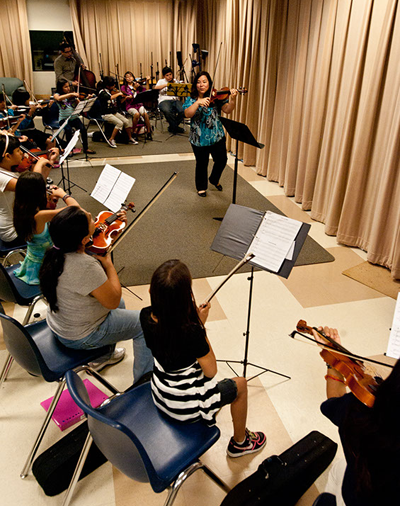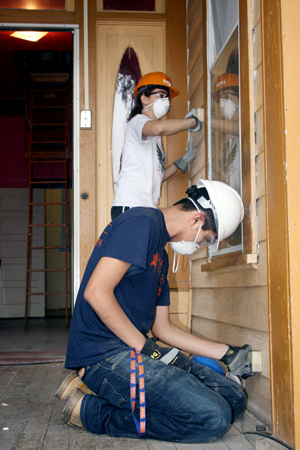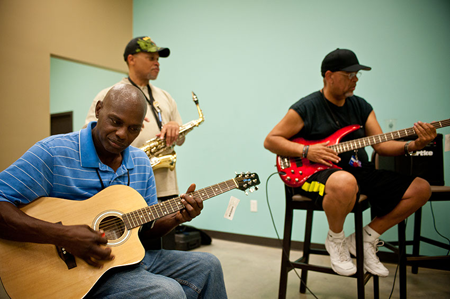

itting in a semicircle in a classroom in the basement of the Durango Building, 13 schoolchildren are learning to fine-tune their violin strokes at the direction of Gabriela Torres, assistant director of the UTSA Downtown String Project.
"A, B, F-sharp, G," Torres instructs them. Then, on cue, the adolescent musicians strike the strings of their violins with varied short and long strokes as they work on a new line from the Cole Porter musical, Can Can.
Amy Baez, 9, is enrolled in the music program along with her 11-year-old brother, Jahaziel. She said she looks forward to attending the two-hour class, which is held after school on Mondays and Thursdays.
"It’s good to come here because we get to learn a lot of new things," said the fourth grader. "It makes me feel good when we play our music, and I’m learning to play the violin just like they do at the symphony."
The string project is just one of many programs undertaken by the Downtown Campus to forge bonds of goodwill and support with the local community.
"We have a number of programs and coursework that link the university with the community and the neighborhood," said Jesse Zapata, vice provost of the Downtown Campus. "A lot of them have to do with our location. For instance, public administration is a natural with all the government entities that surround us. Criminal justice is a natural because of the nearby law enforcement entities, and architecture is a natural because of the surrounding urban environment."
The string project, for example, offers musical instruction in cello, violin, viola and guitar two days a week to 72 inner-city kids from San Antonio, South San and Edgewood independent school districts, who, without these free or low-cost classes, might otherwise not have access to quality music lessons.
Classes are taught by six UTSA music majors who gain just as much in practical teaching experience as the children do in developing their musical talents.
"We’re meeting a critical need. These children don’t have opportunities that students do who live in more affluent parts of the city," said Gene Dowdy, UTSA associate professor of music and founder/director of the project. "Historically, in underserved school districts, such as South San and San Antonio, their budgets don’t allow them to hire teachers to provide their students with classical orchestra training."
Building a Community
Nestled within the urban environment, the College of Architecture is just a few miles from the Dignowity Hill Historic District on the city’s East Side. This neighborhood, with its Victorian-style houses and Craftsman bungalows, was established in the late 1800s as an exclusive residential area for the city’s elite. But, over time, the area has begun to show its age. Once-grand houses now stand neglected.
In response, student Laura Carrera founded the Historic Preservation Association student organization at UTSA, whose 70 members serve as project leaders for the restoration of homes in the Dignowity Hill neighborhood. At the group’s first major neighborhood event in November 2010, about 250 students partnered with the City of San Antonio’s Office of Historic Preservation to refurbish 13 homes in the district listed as endangered properties.
"It was an amazing experience for graduate students to get involved with the community and make a difference while using their knowledge and getting an opportunity to learn to be leaders," Carrera said. "It’s been very rewarding."
The neighborhood benefits as well, she said.
"Seeing young people working on these buildings inspires neighbors to do rehab projects instead of waiting for a building to fall apart," she said. They know they have the support of architecture students who will be willing to help, she added.
The students’ work doesn’t end there, however. Architecture students are also working with the San Antonio Alternative Housing Corp., a nonprofit organization that provides housing for low- and moderate-income communities, with the design and construction of four energy-efficient homes on the city’s West Side near the Guadalupe Cultural Arts Center.
The project, which has $65,000 allocated per home, was funded by a federal HUD grant. Three teams of graduate students designed and built the 1,050-square-foot houses after researching various home materials, construction methods and components of sustainability.
Rod Radle, executive director of the housing agency, said his organization and the College of Architecture will monitor and compare the energy usage of each home over the next several years to help determine the most cost-effective way to build energy efficient and affordable homes in San Antonio.
"Theoretically, hundreds of homes will be built," Radle said. "The College of Architecture is not just impacting the community with these four homes, but can have an impact through the development of hundreds of houses for low- to moderate-income families in the future."
Crime and justice
In March 2009, Nanette C.’s 14-year-old son was attacked by another student while waiting at a bus stop near his middle school. Three of his teeth were broken and his nose was bloodied. His total medical and dental bills exceeded $1,200.
"When I went to the school and saw my son with blood all over him, it was heart-wrenching, and I went into a rage," said Nanette, who asked that her full name not be used. "I was very upset and I wanted that boy to have to pay for what he did and to be punished."
While prosecutors wouldn’t pursue the case, they told Nanette and her family about a program run by the UTSA Department of Criminal Justice— the Restore to Justice Initiative. In addition to reintegrating recently released offenders into society, the program provides an opportunity for victims to meet their offenders to tell them of the suffering their actions caused.
A month after the incident, Nanette and her family met with the assailant and his father.
"My son read a letter and talked about how the incident brought a lot of pain to me, his dad and younger brothers," she said. "My son also told the other boy about the embarrassment he suffered at school."
After her family spoke, Nanette said the offender looked at her son and apologized.
"After learning about his family dynamics and [his] being raised by a single parent, and after hearing a heart-felt apology, I felt sorry for him," Nanette said. "I went from rage and hatred to feeling a sense of peace and understanding. That’s what this program did to us. This never would have happened if we had gone through the justice system. I might have still hated him.
She added that the boy’s father told his son that he would have to get a job to repay the family’s dental bill.
Roger Enriquez, associate professor and chair of the Department of Criminal Justice, said the program offers a different way of looking at safety. "[Offenders] listen to people impacted by crime. It provides an opportunity for offenders and victims to meet one another, and to assist the offender in realizing the impact their crimes have had," he said.
In addition to the Restore to Justice initiative, criminal justice students also deal with more traditional crime-fighting techniques. With a grant from the federal Bureau of Justice Assistance, students work with the San Antonio Police Department in the Crime Analysis Consortium. The consortium trains student interns in law enforcement analytical support.
"We work with the San Antonio Police Department to train students to be crime analysts," Enriquez said. "[The SAPD] will use their financial and human resources fighting crime and not have to use resources for training personnel to be crime analysts. While our students work with the SAPD, they might find themselves in different agencies at the state or federal level. And they are able to learn on the job."
Now in its second year of funding, the partnership has enriched the learning experience of the students and provided key analytical support to core investigative units within the police department, said SAPD Assistant Chief Geraldine Garcia.
The students work hand in hand with detectives and supervisors on ongoing investigations.
"During their tenure, these students became invaluable go-to support personnel while gaining practical experience," Garcia said. "This first-of-its kind program for San Antonio truly illustrates the potential benefit that can be gleaned by public safety agencies partnering with colleges and universities to expand the overall police mission and benefit the community."
Partnering for hope
When Anthony Oliver, 52, came to San Antonio from North Carolina to live with his 32-year-old daughter and her three children, the Gulf War veteran soon found out there wasn’t enough room for him in their small apartment.
Oliver sought shelter at Haven for Hope of Bexar County, a private, nonprofit organization that offers education, job training and behavioral health services as well as shelter to men, women and children in Bexar County. While the facility’s staff helped him get an apartment and file for disability and retirement, UTSA’s College of Public Policy helped him reconnect with his musical background.
As part of the college’s efforts to support the neighboring community, the Department of Social Work created the B Heard Music Café, where students recruited professional musicians to donate their time to perform alongside Haven for Hope musicians. The students also obtained instruments for the Haven members, said Bob Ambrosino, senior lecturer in the Department of Social Work.
It was just one of several collaborations between the social work department, SAMMinistries and Haven for Hope.
"I started practicing music again to take up my time in between filing my claims," said Oliver, who learned to play the guitar and keyboard when he was 12. "The [B Heard Music] café has inspired me to practice and rehearse more, and I’m following my passion, which has been re-ignited."
The overall goal is to develop a unique connection between the San Antonio community and the Haven for Hope community through music, Ambrosino said.
"We have found that there are many homeless people who were musicians at some time in their life, but have lost touch with their connection to music as a result of becoming homeless," he said.
Programs such as B Heard Music Café allow students to be exposed to a hands-on learning experience that will transform their lives, and to connect with the larger community in which they live and work, Ambrosino said.
Zapata said the Department of Social Work’s involvement at Haven for Hope illustrates the many powerful contributions that UTSA makes to the San Antonio community through the Downtown Campus.
"The students all gain experience with and a better understanding of the needs of the people that they serve or will serve," he said. "I believe the work they do is a wonderful example of how UTSA contributes to the community. It also illustrates how UTSA is committed to collaborating with a variety of community agencies and organizations for the betterment of San Antonio."



